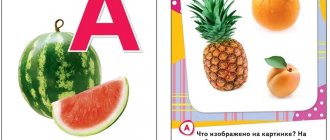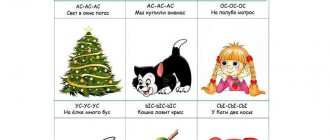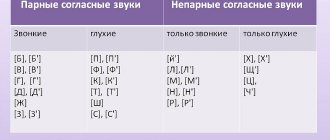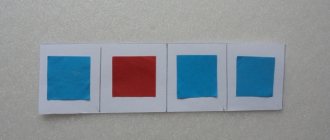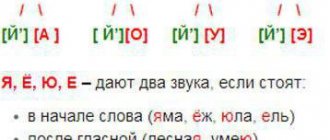Clarify the words: Russian language!
Newsletter closed
Upon closing, subscribers were transferred to the “Your Simple Business Assistant” mailing list, which we recommend that you subscribe to.
You can find mailings on similar topics in the Mailing Directory.
| October 2010 | ||||||
| 1 | 2 | 3 | ||||
| 4 | 5 | 7 | 8 | 9 | 10 | |
| 11 | 12 | 14 | 15 | 16 | 17 | |
| 18 | 19 | 21 | 22 | 23 | 24 | |
| 25 | 26 | 28 | 29 | 30 | 31 | |
Author Easy Speak Courses
Statistics
1.977 subscribers +1 per week
- Issues
- Statistics
All episodes
Yotated vowels
[td]
| Issue No. 86 dated 2010-10-20 www.clearwords.ru Number of people who received this issue: 1875 |
“For civilization to survive, it is necessary to instill in children the habit and ability to learn at school. School is not a place where children are sent so that they do not get in the way of adults during the day. It would be too expensive. School is also not designed to make parrots out of children. School is a place where learning skills are developed and where children can be prepared to face real life, taught to cope with it competently and prepared to take control of tomorrow's world, in which today's adults will be elderly people and old people "
— L. Ron Hubbard.
Hiccup. Yotated vowels
We present to our readers the 89th lecture of the Church Slavonic alphabet course, given by philologist Sergei Naumov. A Church Slavonic language course was shown on the Orthodox TV channel Soyuz. The lectures were given by Sergei Anatolyevich Naumov, candidate of philological sciences, coordinator of the Church Slavonic seminar at the Alexander Nevsky Lavra. We continue showing the second part of the course, dedicated to the Church Slavonic alphabet. Today we bring to the attention of RNL readers the 89th lecture of the Church Slavonic alphabet course, given by philologist Sergei Naumov - “Ykanye. Yotated vowels."
First lecture . "General overview of the Church Slavonic alphabet."
Second lecture . "The letter "Az"".
Third lecture. "The letter "E"".
Fourth lecture . "The letter "O"".
Fifth lecture . "The letter "I"".
Sixth lecture . "The letters "U" and "I"."
Seventh lecture . “Letters for consonant sounds” (parts one and two).
Eighth lecture . "Surscripts" (parts one, two, three and four).
Ninth lecture . "Punctuation marks".
Tenth lecture . "Holiday Signs"
Eleventh lecture . "Introduction to Historical Phonetics".
Lecture Twelve . “The Law of the Open Syllable” (parts one and two).
Thirteenth lecture . "Origin of Slavic vowels".
Lecture fourteen . “The rule of syllabic synharmonism.”
Fifteenth lecture . “Iot palatalization.”
Lecture sixteen . "Noun".
Lecture seventeen . "Types of Declension of Nouns."
Eighteenth lecture . "First Declension".
Nineteenth lecture . "Second Declension".
Twentieth Lecture . "Third declension
Twenty-first lecture . "Fourth Declension".
Twenty-second lecture . "Vocative case".
Twenty-third lecture . "Pronouns."
Twenty-fourth lecture . "Demonstrative pronouns."
Twenty-fifth lecture . “And others like him.”
Twenty-sixth lecture . "Pronouns and articles."
Twenty-seventh lecture . "Declination of pronouns."
Lecture twenty-eight – “Adjective”.
Lecture twenty-nine – “Declination of adjectives.”
Lecture Thirty - “Degrees of Comparison of Adjectives. Substantivization
Thirty-first lecture - “Numerals in Old Church Slavonic”
Thirty-second lecture - “Types of Church Slavonic numerals”
Thirty-third lecture - “Declination of numerals”
Lecture Thirty-four - “Fundamentals of the Verb”
Thirty-fifth lecture “Verb classes”
Thirty-sixth lecture “Review of times. Part 1"
Thirty-seventh lecture “Review of times. Part 2"
Thirty-eighth lecture “Review of times. Part 3
Thirty-ninth lecture “Present Tense”
Fortieth lecture “Aorist. Part 1"
Forty-first lecture “Aorist. Part 2 (Be)"
Forty-second lecture “Imperfect, part 1”
Forty-third lecture “Imperfect, part 2”
Forty- fourth lecture “Future tense”
Forty- fifth lecture “Perfect times”
Forty- sixth lecture “Plusquaperfect”
Forty - eighth lecture “Communion”
forty- eighth “Real participles of the present tense. Part 1"
forty- nine “Real participles of the present tense. Part 2"
Lecture 50 : Real Participles of the Past Tense
Fifty-first lecture “Full and short active past participles”
Fifty-second lecture "El Communions"
Fifty- third lecture “Present Passive Participles”
Fifty- fourth lecture “Pastive participles of the past tense”
Fifty- fifth lecture “Complex object with participle”
Fifty- sixth lecture “Dative independent”
Fifty - eighth lecture “Continuous forms”
Fifty- eighth lecture “Adverbial participles”
Fifty- ninth Lecture “Imperative Mood”
Lecture sixty “Desirability”
Sixty-first lecture “The subjunctive mood”
Sixty- second lecture “Dual number”
Sixty- third lecture “On adverbs”
Sixty- fourth lecture “Formation of adverbs”
Sixty- fifth lecture “The meaning of adverbs”
Sixty- sixth lecture “Category of condition”
Sixty - seventh lecture “Prepositions”
Sixty- eighth lecture “Unions: a general overview”
Sixty- ninth lecture “Unions in examples. Part 1"
Seventieth lecture “Unions in examples. Part 2"
Seventy-first lecture “Unions in examples. Part 3"
Seventy-second lecture “Unions in examples. Part 4"
Seventy- third lecture “Unions in examples. Part 5"
Seventy- fourth lecture “Particles”
Seventy- fifth lecture “Interjections”
Seventy- sixth lecture “Acoustics”
Seventy - eighth lecture “Anatomy of the speech apparatus”
Seventy- eighth lecture “Articulatory classification of vowels”
Seventy- ninth lecture “Articulatory classification of consonants”
Eightieth lecture “Sound and phoneme”
Eighty-first lecture “Where to go to study?”
Eighty- second lecture “What to read?”
Eighty- third lecture “Sound and phoneme”
Eighty- fourth lecture “From sound to letter”
Eighty- fifth lecture “Transcription signs. Part 1"
Eighty- sixth lecture “Transcription signs. Part 2"
Eighty - seventh lecture “Akanye in church and literary pronunciation”
Eighty- eighth lecture “Hiccups in church and literary pronunciation”
Definition
Yotated vowels are vowels that in certain cases make up 2 sounds (e, ё, yu, i). Accordingly: e=ye, yo=yo, yu=yu, ya=ya. Example: Yotated vowel letters always represent only two sounds.
Let's look at cases where these vowels consist of two sounds.
1. At the beginning of a word. For example, when you say the word "yama" [yama].
A few more examples when a vowel is at the beginning of a word: Hedgehog, Raccoon, Yula, Apple.
2. After vowels, for example in the word “hare” [hare].
A few more examples: application, shelter, Pelageya.
3. After the letters ъ, ь, for example in the word “blizzard” [vyuga]
More examples when a vowel comes after b or b: entry, bindweed, Natalya.
What are iotated vowels
There are 10 vowel letters in the alphabet, but among them there are 4 letters whose spelling and sound are different (discrepancy between phonetics and graphic design). Such letters are called “iotated”, since their sound composition contains [th'].
Iotated vowels in Russian include:
- I (apple, berry, look);
- Yu (spinning top, prickly, sing);
- E (spruce, white, runs);
- Yo (hedgehog, salty, protects).
They differ from other vowels in the following features:
- Can represent two sounds:
✓ I - [th'] [a] under stress (friends - [friends'y'a]);
✓ i - [th'] [and] for unstressed position (rows - [ry'ids]);
✓ Yu - [y'] [y] in a stressed and unstressed position (with salt - [sol'y'u]; pain - [bol'y'u]
✓ E - [th'] [e] under stress (Pierre - [p'y'er]);
✓ E - [th'] [i] for unstressed position (train - [poy'izt]; felt boots - [val'inok]; run - [b'izhat'];)
✓ Yo - [y'] [o] (tree - [y'olka])
This property depends on the position of the corresponding letter in the word. And it applies when the letters:
[x] are at the beginning of a word:
✓I: hawk - [y'ast'ip]; bright - [y'ark'iy']; anchor - [y'akar'].
✓ yu: skirt - [y'upka]; yunga - [y'unga]; southern - [y'uzhny'];
✓ e: spruce - [y'el']; raccoon - [y'enot]; blackberry - [y'izhyv'ika];
✓ ё: hedgehog - [y'ozhyk]; Christmas tree - [y'olka]; brush - [y'orshyk];
[x] are found after vowels:
✓ I: bayan - [bai'an]; bark - [lay'at']; faience - [faience];
✓ yu: sing - [pay'ut]; cabin - [kai'uta]; shelter - [priy'ut];
✓ё: forges - [kuy'ot]; sings - [pay'ot]; laughs - [sm'ii'ots:a];
✓ e: ate - [pay'el]; fighter - [bai'ets]; flies - [r'ey'it];
[x] are located after the soft and hard signs:
✓ i: polynya - [palyn'y'a]; hugs - [aby'at'iya'a]; family - [s'em'y'a];
✓ yu: pour over - [piril'y'u]; pre-anniversary - [pr'idy'ub'il'ey'n y'];
✓ е: rise - [fall]; lies -[vran'y'o]; shrank - [sy'ozhyls'a];
✓ e: ate - [sy'el]; singing - [p'en'y'e]; entry - [v'y'est]
- Can denote one sound and the softness of the preceding consonant:
[x] I - [a] (mint - [m'ata]; row - [r'at]; cassock - [r'asa])
[x] yu [y] (chandelier - [l'ustra]; Lyuba [l'uba]; frock coat [s'urtuk]);
[x] e [e] (forester - [l'esnik]; parquet - [park'et]; spring - [v'esna]);
[x] ё [o] (film - [plonka]; herring - [s'il'otka].
- They can denote one sound and do not indicate the softness of the preceding hard consonants “zh”, “sh”, “ts”:
[x] i - after “zh”, “sh”, “ts” is not written, but “a” is used;
[x] yu - after “zh”, “sh” is not written, but “u” is used (exception: brochure - [brushura], jury - [zhur'i], parachute - [parachute] and names of geographical objects, surnames, names of foreign origin). After “ts” is possible only in words of foreign origin (Zurich - [tsur'ikh]);
[x] e under stress - [e] (six - [shest]; to march - [shestvavat']);
[x] e in the unstressed position [ы] or [ъ] (sixty - [шъст'д'ышат]; Shakespeare - [shyksp'ir]);
[x] ё - [o] (silk - [sholk]; burnt - [zhok]; yellow - [zholty']).
According to “zh”, “sh”, “ts” always denote hard sounds [zh], [sh], [ts], therefore the letters “yu”, “e”, “e” turn into the sounds [u], [e ], [O].
Iotated letters play a dual role in a word and can represent one or two sounds at once in certain positions. Also, the change in the phonetic structure of these letters also depends on the stressed or unstressed position. It is important to remember that the phonetic composition of such iotated vowels includes a soft consonant sound [th'].
Impact position o, e in combination with hissing
In a strong position to convey the sound [e], after hissing words you should write e. For example: pearl, tin, whispers, rustle, crack, rubble, goal, centner, jaw, honor.
Vowels o/e after sibilants obey their own rules.
First, let's look at when to write about.
- If it is part of the ending of nouns or adjectives (barzhoy, mezhoy, shoulder, gun, stranger, big), as well as a suffix of adverbs: hot, fresh.
- If is a suffix of a noun. Let us list the variants of such morphemes: -ok- (buddy, circle, pie, jump); -onk- (little book, little piece of paper, little money, girls, boys, barrels); -onok-/-chonok- (barrel, little pebble, little hare, little badger); -onysh (as a rule, these are colloquial words: uzhonysh, little one); -ovk- (raincoat, combat jacket, small items); -about- (slum, thicket); -otk- (ratchet) and the last suffix -ovshchin- requires the ending a: stabbing.
- If it is a suffix of the adjective -ov-: penny, walrus, brocade. This also includes nouns derived from these words that end in she -ovka-/-ovnik-: tsynovnik, parchovka, groshovka, grushovka, rechovka. The suffix -ov- is also often found in surnames. Here it is worth focusing on the documents given at birth. So, it can be written Borschov and Borshchev, Khrushchov and Khrushchev, Kumachov or Kumachev.
- If it is an adverb or adjective with the suffix -okhonk-: small (small), svezhokhonky (freshly). These words are colloquial.
- If is fluent in nouns and adverbs: zhor (eat); burn (burn); trouble (rozhon); intestines (kishok – genitive case).
- If the word is borrowed and the vowels after the sibilants are in its root: joker, shorts, anchovy, major, Joyce (proper names also obey this rule).
And or s in combination with c
Let's look at what vowels should be written after c. The letter s is written in the following cases:
- If it comes at the end of a noun or adjective. For example: three capitals, brave fellows, short fur, narrow-faced man, pickled cucumbers.
- In proper and common nouns with the suffix -yn or -tsyn-: Tsaritsyno, Golitsyn, fox tail, marten fur.
- In some exception words: gypsy (and all its derivatives), chicken, chuck, tiptoe.
In surnames and or ы after c is not regulated by the rule, only by title documents, which indicate the correct spelling. Let’s say the surnames Kunitsyn and Staritsyn are spelled y, but Yeltsin or Vitsin must be written with and.
Now let's look at cases when after q it is necessary to use i. These are all those that do not fall under the rules listed above.
- Word roots (except for the exceptions listed in paragraph 3 of the previous rule). For example: figure, circus, tsigeika, specific, cylinder, Tsiolkovsky, vaccine.
- Suffixes of foreign language origin: constitution, revolution, organization, interpretation, medicine, routing, calcite.
- As a link between parts of a complex word and in abbreviations, the following is also written: VTsIK, special interview, blitzinform.
When should you write e under stress?
Let us list the cases when e should be written in the root after a hissing word:
- In verb endings, the 1st person is -eat (bake, cut, lie), 2nd person -eat/-e (burn, lie, bake, burn, lie, bake) and 3rd person -et (bakes, lies, burns).
- If the verb ends in -evovat: chew, demarcate; in participles formed from similar words: delimited, chewed; verbal nouns: delimitation, shading.
- If the word is a noun formed from a verb: spend the night - overnight, uproot - uproot, stew - stew, migrate - migration.
- If the word has the suffix -er (as a rule, it means some kind of activity): boyfriend, conductor, traveling salesman, trainee, trainer.
- If the word is a passive participle: baked, muted, immersed, set on fire.
- If you can find a word where e is clearly heard at the root. Lattice - sieve; brush - bristles; wool - wool; chewed - chew; hard - tin; liver - liver; perch - pole; acorn - (no) acorns; bangs (chelo – obsolete “forehead”); whisper - whisper; dandy - flaunt; cheeks - cheek. It should be noted that there are proper names that do not follow this rule.
- In the interrogative relative pronoun that, used in the prepositional case (about what), there are also derived words (nothing, nothing, and).
What vowel letters represent 2 sounds?
Everyone knows that consonants can be hard and soft. If after consonant letters there are vowels E, Ë, Yu, I, then they indicate the softness of the previous one.
For example: children, ice, trousers, woodpecker.
If you pronounce these words slowly, the sounds E, O, U, A can be clearly heard.
An equally interesting example is when the letters E, S, Yu, I come first.
What happens in this case?
Let's look at examples:
- raccoon
- the letter E gives two sounds [YE];
- hedgehog
- begins with Ë, giving 2 sounds [YO];
- yurt
- Yu gives 2 sounds [YU];
- pit
- also two sounds [YA].
It can be noted that in these words the first thing heard is Y (yot), therefore such vowels are usually called iotized.
If the letters E, Ë, Yu, I come after vowels, they also make two sounds.
Here is a striking example of such a phonetic position:
- hygiene
- gig[YE]na;
- sings
— po [YO]t;
- cabin
- ka[YU]ta;
- hare
- for [YA]ts.
And that is not all. There is a third option, when vowels represent two sounds. Please note that the letters E, Ë, Yu, I, standing after the disjunctive signs b and b, make two sounds.
You can verify this by looking at examples:
- pours
- l[YO]t;
- leaving
- time[YE]zd;
- serious
- serious;
- cringe
- get together;
- drink
- p[YU]t;
- adjutant
— ad[YU]tant;
- weeds
— bur[YA]n;
- announcement
- announcement.
O and e in unstressed position
As for spelling o or e in an unstressed position, you need to remember that in a weak position you should write the letter that is heard in a strong position. This applies to both roots: tin - tin; wool - wool; turn yellow - yellow; and suffixes: key, raincoat, scourge; and endings: husband, watchman, redhead.
You should remember foreign words in which in an unstressed position it is written about: majordomo, highway, shock, lecho, Chopin, poncho, banjo and others. Their spelling should be checked with a spelling dictionary.
If a word has the prefix inter-, and the root begins with a vowel in a weak position, then you should write about: intersectoral, interorbital. This rule also applies to complex abbreviated words: leather and shoe.
Positions in words of vowel letters making 2 sounds
The positions of vowel letters producing two sounds require certain conditions to be met. We reviewed them above.
To make it easier to remember the rule, you can use the notation table.
| Yotated vowels E, Ë, Yu, I give 2 sounds if they stand: | ||
| at the beginning of a word | after a vowel | after the disjunctive b or b sign |
| anchor | snake | courier detour |
Letters a, y after sibilants
The use of the term "sibilant consonants" is quite common. What does it mean? These are the sounds that, when articulated, are accompanied by a characteristic hissing design. This is w, w, sch, h, c.
It should be said that initially they had a pair in softness or were always hard, but with the development of language they either lost the pair (for example, [zh], [sh]) or from originally hard they became soft ([h]).
This explains the vowel that comes after them. A standing sibilant after a vowel, as a rule, does not affect anything. So, after sibilants, only a or y is always written (the use of i or yu is considered a gross mistake). For example: Jacqueline, jasmine, creepy, screw, shawl, sorrel, pike, thicket, seagull, heron, tsunami.
This rule does not apply to words of foreign origin, some surnames and toponyms: brochure, Jules, Qianjian, parachute, jury, Kotsyubinsky, Steponavichyus.
